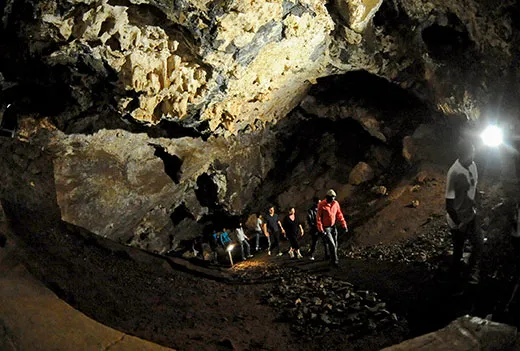Evolution World Tour: The Cradle of Humankind, South Africa
The world’s greatest source of hominid fossils is among dozens of caves just hours from Johannesburg
Three million years ago, an eagle soared above an enormous forest in South Africa and zeroed in on its target. Among a group of hominids searching for fruits, nuts and seeds, a 3-year-old child had strayed too far away from its mother. The eagle swooped down, grabbed the 25-pound toddler with its talons and flew off to its nest, perched above the opening to an underground cave. As the eagle dined on its meal, scraps fell into the cave below.
Similarly hair-raising tales—hominids being dragged into caves by leopards or accidentally falling into hidden holes—explain why South Africa’s limestone caves are the world’s greatest source of hominid fossils. About 900 have been recovered from more than a dozen sites scattered over 180 square miles of grassland within a few hours’ drive from Johannesburg. The area is known as the Cradle of Humankind. Scientists have identified at least four hominid species—in addition to our own, Homo sapiens—that lived in this region at various times over the past 3.5 million years.
“Fossils from South African caves have played a critically significant role in the development of our concepts of human evolution,” says C.K. “Bob” Brain, a curator emeritus at South Africa’s Transvaal Museum, who began studying the caves in the 1950s.
The first major discovery of a hominid from the Cradle came in 1924, when the anatomist Raymond Dart found an unusual, bumpy rock among rubble that had been sent to him from a quarry. After months of chipping away at it with one of his wife’s knitting needles, Dart liberated a skull and stared into the face of what appeared to be a young ape that looked surprisingly human. Now known as the Taung Child after the town where it was discovered, it was the first evidence of the species Australopithecus africanus. (More recently scientists have determined that two holes in the skull were made by an eagle’s talons.)
Prior to Dart’s discovery, scientists thought human ancestors emerged in Europe or Asia. The Taung and other fossils—more primitive than Eurasian hominids but still possessing human characteristics, such as the ability to walk upright—compelled early-hominid hunters to shift their search to Africa.
Hominids began to diverge from chimpanzees about seven million years ago. In the Cradle, the oldest-known species is Australopithecus africanus. The four-foot-tall hominid with long arms for tree climbing lived in the region 3.3 million to 2.1 million years ago, when the area was partly forested. As the climate became drier, the forests gave way to more open grasslands, and new hominids evolved. Paranthropus robustus— famous for its massive jaw and giant molars, which allowed the species to chew tough plants—inhabited the area 1.8 million to 1.2 million years ago. It lived alongside the taller, more modern-looking Homo erectus, which also came onto the scene about 1.8 million years ago before disappearing from Africa 500,000 years ago. Farther afield from the Cradle, spread out along South Africa’s southern coast, cave sites such as Blombos Cave, Pinnacle Point and the Klasies River Caves record key evidence of early complex behavior in our own species. Homo sapiens began using red pigments, making blades and eating seafood as early as 164,000 years ago.
Visitors to the Cradle of Humankind can take guided walking tours of Sterkfontein and see a replica of “Little Foot,” a specimen recovered in 1997 that is among the most complete Australopithecus skeletons ever found. The location of one of the Cradle’s most famous specimens—the roughly two-million-year-old Australopithecus africanus skull nicknamed Mrs. Ples (who scientists now think is actually Mr. Ples)—is another highlight of the tour. Those who want to see an active excavation site can arrange private tours of Swartkrans—a cave that is home to an abundance of stone and bone tools dating back almost two million years and some 270 burned bones estimated to be more than one million years old. These bones may be evidence of the earliest known controlled fires. “There’s a rich behavioral record at Swartkrans that we’re trying to plumb for as much information as we can,” says Travis Pickering, a paleoanthropologist at the University of Wisconsin-Madison and director of the Swartkrans Paleoanthropological Research Project.
One question Pickering is trying to answer is who made the tools and tended the fires. Both species that lived in the area at the time—Homo erectus and Paranthropus robustus—were probably capable of manufacturing tools, he says. “We’re trying to investigate and disentangle...what behaviors distinguish these two closely related species.”
One of the most exciting discoveries from the Cradle of Humankind came in 2010, when researchers led by Lee Berger, a paleoanthropologist at the University of the Witwatersrand, announced they had unearthed a new hominid species, Australopithecus sediba, in South Africa’s Malapa Cave. The hominid, nearly two million years old, shares enough crucial features with the genus Homo that its discoverers think it might be the long-sought direct ancestor of our genus, filling in a blank spot in the fossil record. If so, then the Cradle could be the site where hominids evolved beyond their more ape-like features and moved closer to being human.
/https://tf-cmsv2-smithsonianmag-media.s3.amazonaws.com/accounts/headshot/science-erin-wyman-240.jpg)


/https://tf-cmsv2-smithsonianmag-media.s3.amazonaws.com/accounts/headshot/science-erin-wyman-240.jpg)